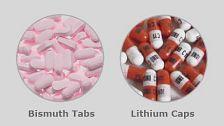Bismuth and Lithium
| Cellular NutritionBismuth (Bi) and Lithium (Li) are associated trace elements. While bismuth is not classified as essential for humans at this time, lithium is a nutritionally essential trace element with a potential to decrease mortality, and provide anti-aging capabilities.[1] Although not related on the Periodic Table of Elements, bismuth and lithium are biologically associated on a gastrointestinal and mental health level. While lithium is better known for its therapeutic properties with bipolar / manic-depressive disorder, both elements exert a similar effect on their respective chemical environment: Lithium in regard to potassium / sodium balance, and bismuth in regard to phosphorus / zinc balance.
Shared toxicity / overdose symptoms of bismuth and lithium include kidney or liver damage, hypoadrenalism (bismuth), hypothyroidism (lithium), mental confusion, staggering gait, tremor, memory problems, and others. Magnesium can be used to treat lithium overdose, while calcium can be used to treat bismuth overdose.

In addition to treating patients with Manic-Depressive Illness, lithium has been used with some success for Ménière's disease, Huntington's Chorea, and alcoholism. In animal models, lithium has been reportedto be beneficial for brain injury, spinal cord injury, stroke, Parkinson's disease, and ALS (amyotrophic lateral sclerosis), whereby recent clinical trials suggest hat lithium may stop the progression of ALS.
Raising below-normal levels of lithium or bismuth can, but does not have to produce any positive effects in regard to mental health, since few lithium or bismuth-deficient individuals present with actual mental illness, although some researchers claim that areas with the highest lithium levels in drinking water have the lowest rates of homicides, and the lowest mental hospital admissions (those findings have not been officially accepted).
When indeed indicated for bipolar disorder,[2] patients typically present with low lithium levels and very high sodium levels, whereby lithium provides a balancing effect. The intake of higher amounts of lithium has a tendency to raise sodium, and frequently also potassium through its effect on kidney functions, and it has a tendency to raise manganese through its effect on liver functions (which depresses thyroid activity), so there is a distinct biochemical conflict that has a genetic basis. Otherwise everyone with low lithium levels (which are actually quite common), would be suffering from manic-depressive episodes. Regardless, it is estimated that lithium resolves Manic Depression in about one third of patients; it is said to improve the lives of another third, and is ineffective for the rest.
Bismuth and Lithium frequently test low in patients who suffer from low stomach acid levels corresponding to upper (bismuth) and lower (lithium) parts of the stomach, and they are invariably always low in those with an active infection of the Helicobacter Pylori bacterium, which is responsible for some gastric ulcers and a number of other medical conditions (see "H. Pylori" for details).
Bismuth, through its antimicrobial action, is more appropriate for peptic involvement to inhibit H. Pylori activity, where it supports an increase in upper stomach acid levels, while lithium is more indicated for lower gastric / duodenal involvement, where it supports an increase in lower stomach acid levels.

 Manganese may help with some symptoms of Parkinson's disease such as muscle rigidity and twitching...
Manganese may help with some symptoms of Parkinson's disease such as muscle rigidity and twitching...
 Research shows that phytosterols such as beta-sitosterol may help normalize the function of natural killer cells and T-helper lymphocytes...
Research shows that phytosterols such as beta-sitosterol may help normalize the function of natural killer cells and T-helper lymphocytes...
 Iron deficiency may be suspect with some forms of ADHD. 84% of children with ADHD were found to have abnormally low levels of ferritin...
Iron deficiency may be suspect with some forms of ADHD. 84% of children with ADHD were found to have abnormally low levels of ferritin...
 A high intake of B Vitamins can trigger heart palpitations, HBP, major complications in patients with congestive heart disease...
A high intake of B Vitamins can trigger heart palpitations, HBP, major complications in patients with congestive heart disease...